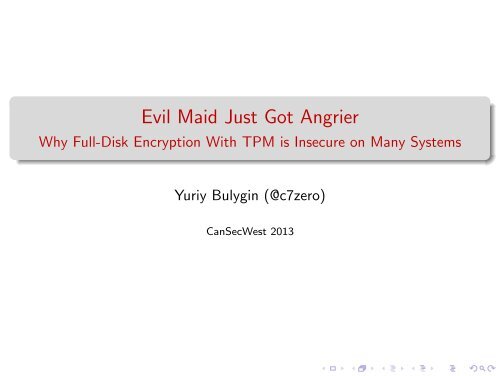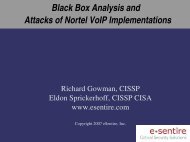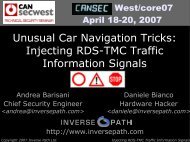Evil Maid Just Got Angrier - Why Full-Disk Encryption ... - CanSecWest
Evil Maid Just Got Angrier - Why Full-Disk Encryption ... - CanSecWest
Evil Maid Just Got Angrier - Why Full-Disk Encryption ... - CanSecWest
Create successful ePaper yourself
Turn your PDF publications into a flip-book with our unique Google optimized e-Paper software.
<strong>Evil</strong> <strong>Maid</strong> <strong>Just</strong> <strong>Got</strong> <strong>Angrier</strong><br />
<strong>Why</strong> <strong>Full</strong>-<strong>Disk</strong> <strong>Encryption</strong> With TPM is Insecure on Many Systems<br />
Yuriy Bulygin (@c7zero)<br />
<strong>CanSecWest</strong> 2013
Outline<br />
1 UEFI BIOS
Outline<br />
1 UEFI BIOS<br />
2 Measured/Trusted Boot
Outline<br />
1 UEFI BIOS<br />
2 Measured/Trusted Boot<br />
3 The Real World: Bypassing Measured/Trusted Boot
Outline<br />
1 UEFI BIOS<br />
2 Measured/Trusted Boot<br />
3 The Real World: Bypassing Measured/Trusted Boot<br />
4 Windows BitLocker with TPM
Outline<br />
1 UEFI BIOS<br />
2 Measured/Trusted Boot<br />
3 The Real World: Bypassing Measured/Trusted Boot<br />
4 Windows BitLocker with TPM<br />
5 Secure Boot
Outline<br />
1 UEFI BIOS<br />
2 Measured/Trusted Boot<br />
3 The Real World: Bypassing Measured/Trusted Boot<br />
4 Windows BitLocker with TPM<br />
5 Secure Boot<br />
6 What Else?
Outline<br />
1 UEFI BIOS<br />
2 Measured/Trusted Boot<br />
3 The Real World: Bypassing Measured/Trusted Boot<br />
4 Windows BitLocker with TPM<br />
5 Secure Boot<br />
6 What Else?<br />
7 Anything We Can Do?
Outline<br />
1 UEFI BIOS<br />
2 Measured/Trusted Boot<br />
3 The Real World: Bypassing Measured/Trusted Boot<br />
4 Windows BitLocker with TPM<br />
5 Secure Boot<br />
6 What Else?<br />
7 Anything We Can Do?
Legacy BIOS
Legacy BIOS<br />
CPU Reset vector in ROM → legacy boot block<br />
Basic CPU, chipset initialization →<br />
Initialize Cache-as-RAM, load and run from cache →<br />
Initialize DIMMs, create address map.. →<br />
Enumerate PCIe devices.. →<br />
Execute Option ROMs on expansion cards<br />
Load and execute MBR →<br />
2nd Stage Boot Loader / OS Loader → OS
Legacy BIOS<br />
CPU Reset vector in ROM → legacy boot block<br />
Basic CPU, chipset initialization →<br />
Initialize Cache-as-RAM, load and run from cache →<br />
Initialize DIMMs, create address map.. →<br />
Enumerate PCIe devices.. →<br />
Execute Option ROMs on expansion cards<br />
Load and execute MBR →<br />
2nd Stage Boot Loader / OS Loader → OS<br />
or a <strong>Full</strong>-<strong>Disk</strong> <strong>Encryption</strong> Application
Legacy BIOS<br />
CPU Reset vector in ROM → legacy boot block<br />
Basic CPU, chipset initialization →<br />
Initialize Cache-as-RAM, load and run from cache →<br />
Initialize DIMMs, create address map.. →<br />
Enumerate PCIe devices.. →<br />
Execute Option ROMs on expansion cards<br />
Load and execute MBR →<br />
2nd Stage Boot Loader / OS Loader → OS<br />
or a <strong>Full</strong>-<strong>Disk</strong> <strong>Encryption</strong> Application<br />
or a Bootkit
Security of Legacy BIOS
Security of Legacy BIOS<br />
Huh?
Security of Legacy BIOS<br />
Huh?<br />
Old architecture<br />
Unsigned BIOS updates by user-mode applications<br />
Unsigned Option ROMs<br />
Unprotected configuration<br />
SMI Handlers.. have issues [18]<br />
No Secure Boot
Unified Extensible Firmware Interface (UEFI)<br />
CPU reset vector in ROM →<br />
Startup/Security Phase (SEC) →<br />
Pre-EFI Initialization (PEI) Phase (chipset/CPU initialization) →<br />
Driver Execution Environment (DXE) Phase →<br />
OEM UEFI applications (diagnostics, update) →<br />
Boot Device Selection (BDS) Phase → UEFI Boot Manager<br />
OS Boot Manager / Loader or Built-in UEFI Shell
Security of UEFI BIOS<br />
UEFI provides framework for signing UEFI binaries including native<br />
option ROMs<br />
Signed capsule update<br />
Framework for TCG measured (trusted) boot<br />
UEFI 2.3.1 defines secure (verified, authenticated) boot<br />
Protected configuration (authenticated variables, boot-time only..)<br />
SEC+PEI encapsulate security critical functions (recovery, TPM init,<br />
capsule update, configuration locking, SMRAM init/protection..)
So is UEFI BIOS secure?<br />
UEFI specifies all needed pieces but it’s largely up to platform<br />
manufacturers to use them as well as protections offered by hardware
So is UEFI BIOS secure?<br />
UEFI specifies all needed pieces but it’s largely up to platform<br />
manufacturers to use them as well as protections offered by hardware<br />
What good are your signed UEFI capsules if firmware ROM is writeable by<br />
everyone?
Outline<br />
1 UEFI BIOS<br />
2 Measured/Trusted Boot<br />
3 The Real World: Bypassing Measured/Trusted Boot<br />
4 Windows BitLocker with TPM<br />
5 Secure Boot<br />
6 What Else?<br />
7 Anything We Can Do?
Measured (Trusted) Boot<br />
Example: TPM Based <strong>Full</strong>-<strong>Disk</strong> <strong>Encryption</strong> Solutions<br />
Pre-OS firmware components are hashed (measured)<br />
Measurements are initiated by startup firmware (Static CRTM)<br />
Measurements are stored in a secure location (TPM PCRs)<br />
Secrets (encryption keys) are encrypted by the TPM and bounded to<br />
PCR measurements (sealed)<br />
Can only be decrypted (unsealed) with same PCR measurements<br />
stored in the TPM<br />
This chain guarantees that firmware hasn’t been tampered with
Windows BitLocker<br />
http://technet.microsoft.com/en-us/library/ee449438(v=ws.10).aspx
BitLocker with Trusted Platform Module<br />
Volume Key used to encrypt drive contents is encrypted by the TPM<br />
based on measurements of pre-OS firmware<br />
If any pre-OS firmware component was tampered with, TPM<br />
wouldn’t decrypt the key<br />
Ensures malicious BIOS/OROM/MBR doesn’t log the PIN or fake<br />
recovery/PIN screen<br />
Implementation of a Measured Boot
Typical Chain of Measurements
Typical Chain of Measurements<br />
⊗ Initial startup FW at CPU reset vector
Typical Chain of Measurements<br />
⊗ Initial startup FW at CPU reset vector<br />
PCR[0 ] ← CRTM, UEFI Firmware, PEI/DXE [BIOS]
Typical Chain of Measurements<br />
⊗ Initial startup FW at CPU reset vector<br />
PCR[0 ] ← CRTM, UEFI Firmware, PEI/DXE [BIOS]<br />
↖ UEFI Boot and Runtime Services, Embedded EFI OROMs
Typical Chain of Measurements<br />
⊗ Initial startup FW at CPU reset vector<br />
PCR[0 ] ← CRTM, UEFI Firmware, PEI/DXE [BIOS]<br />
↖ UEFI Boot and Runtime Services, Embedded EFI OROMs<br />
↖ SMI Handlers, Static ACPI Tables
Typical Chain of Measurements<br />
⊗ Initial startup FW at CPU reset vector<br />
PCR[0 ] ← CRTM, UEFI Firmware, PEI/DXE [BIOS]<br />
↖ UEFI Boot and Runtime Services, Embedded EFI OROMs<br />
↖ SMI Handlers, Static ACPI Tables<br />
PCR[1 ] ← SMBIOS, ACPI Tables, Platform Configuration Data
Typical Chain of Measurements<br />
⊗ Initial startup FW at CPU reset vector<br />
PCR[0 ] ← CRTM, UEFI Firmware, PEI/DXE [BIOS]<br />
↖ UEFI Boot and Runtime Services, Embedded EFI OROMs<br />
↖ SMI Handlers, Static ACPI Tables<br />
PCR[1 ] ← SMBIOS, ACPI Tables, Platform Configuration Data<br />
PCR[2 ] ← EFI Drivers from Expansion Cards [Option ROMs]
Typical Chain of Measurements<br />
⊗ Initial startup FW at CPU reset vector<br />
PCR[0 ] ← CRTM, UEFI Firmware, PEI/DXE [BIOS]<br />
↖ UEFI Boot and Runtime Services, Embedded EFI OROMs<br />
↖ SMI Handlers, Static ACPI Tables<br />
PCR[1 ] ← SMBIOS, ACPI Tables, Platform Configuration Data<br />
PCR[2 ] ← EFI Drivers from Expansion Cards [Option ROMs]<br />
PCR[3 ] ← [Option ROM Data and Configuration]
Typical Chain of Measurements<br />
⊗ Initial startup FW at CPU reset vector<br />
PCR[0 ] ← CRTM, UEFI Firmware, PEI/DXE [BIOS]<br />
↖ UEFI Boot and Runtime Services, Embedded EFI OROMs<br />
↖ SMI Handlers, Static ACPI Tables<br />
PCR[1 ] ← SMBIOS, ACPI Tables, Platform Configuration Data<br />
PCR[2 ] ← EFI Drivers from Expansion Cards [Option ROMs]<br />
PCR[3 ] ← [Option ROM Data and Configuration]<br />
PCR[4 ] ← UEFI OS Loader, UEFI Applications [MBR]
Typical Chain of Measurements<br />
⊗ Initial startup FW at CPU reset vector<br />
PCR[0 ] ← CRTM, UEFI Firmware, PEI/DXE [BIOS]<br />
↖ UEFI Boot and Runtime Services, Embedded EFI OROMs<br />
↖ SMI Handlers, Static ACPI Tables<br />
PCR[1 ] ← SMBIOS, ACPI Tables, Platform Configuration Data<br />
PCR[2 ] ← EFI Drivers from Expansion Cards [Option ROMs]<br />
PCR[3 ] ← [Option ROM Data and Configuration]<br />
PCR[4 ] ← UEFI OS Loader, UEFI Applications [MBR]<br />
PCR[5 ] ← EFI Variables, GUID Partition Table [MBR Partition Table]
Typical Chain of Measurements<br />
⊗ Initial startup FW at CPU reset vector<br />
PCR[0 ] ← CRTM, UEFI Firmware, PEI/DXE [BIOS]<br />
↖ UEFI Boot and Runtime Services, Embedded EFI OROMs<br />
↖ SMI Handlers, Static ACPI Tables<br />
PCR[1 ] ← SMBIOS, ACPI Tables, Platform Configuration Data<br />
PCR[2 ] ← EFI Drivers from Expansion Cards [Option ROMs]<br />
PCR[3 ] ← [Option ROM Data and Configuration]<br />
PCR[4 ] ← UEFI OS Loader, UEFI Applications [MBR]<br />
PCR[5 ] ← EFI Variables, GUID Partition Table [MBR Partition Table]<br />
PCR[6 ] ← State Transitions and Wake Events
Typical Chain of Measurements<br />
⊗ Initial startup FW at CPU reset vector<br />
PCR[0 ] ← CRTM, UEFI Firmware, PEI/DXE [BIOS]<br />
↖ UEFI Boot and Runtime Services, Embedded EFI OROMs<br />
↖ SMI Handlers, Static ACPI Tables<br />
PCR[1 ] ← SMBIOS, ACPI Tables, Platform Configuration Data<br />
PCR[2 ] ← EFI Drivers from Expansion Cards [Option ROMs]<br />
PCR[3 ] ← [Option ROM Data and Configuration]<br />
PCR[4 ] ← UEFI OS Loader, UEFI Applications [MBR]<br />
PCR[5 ] ← EFI Variables, GUID Partition Table [MBR Partition Table]<br />
PCR[6 ] ← State Transitions and Wake Events<br />
PCR[7 ] ← UEFI Secure Boot keys (PK/KEK) and variables (dbx..)
Typical Chain of Measurements<br />
⊗ Initial startup FW at CPU reset vector<br />
PCR[0 ] ← CRTM, UEFI Firmware, PEI/DXE [BIOS]<br />
↖ UEFI Boot and Runtime Services, Embedded EFI OROMs<br />
↖ SMI Handlers, Static ACPI Tables<br />
PCR[1 ] ← SMBIOS, ACPI Tables, Platform Configuration Data<br />
PCR[2 ] ← EFI Drivers from Expansion Cards [Option ROMs]<br />
PCR[3 ] ← [Option ROM Data and Configuration]<br />
PCR[4 ] ← UEFI OS Loader, UEFI Applications [MBR]<br />
PCR[5 ] ← EFI Variables, GUID Partition Table [MBR Partition Table]<br />
PCR[6 ] ← State Transitions and Wake Events<br />
PCR[7 ] ← UEFI Secure Boot keys (PK/KEK) and variables (dbx..)<br />
PCR[8 ] ← TPM Aware OS specific hashes [NTFS Boot Sector]
Typical Chain of Measurements<br />
⊗ Initial startup FW at CPU reset vector<br />
PCR[0 ] ← CRTM, UEFI Firmware, PEI/DXE [BIOS]<br />
↖ UEFI Boot and Runtime Services, Embedded EFI OROMs<br />
↖ SMI Handlers, Static ACPI Tables<br />
PCR[1 ] ← SMBIOS, ACPI Tables, Platform Configuration Data<br />
PCR[2 ] ← EFI Drivers from Expansion Cards [Option ROMs]<br />
PCR[3 ] ← [Option ROM Data and Configuration]<br />
PCR[4 ] ← UEFI OS Loader, UEFI Applications [MBR]<br />
PCR[5 ] ← EFI Variables, GUID Partition Table [MBR Partition Table]<br />
PCR[6 ] ← State Transitions and Wake Events<br />
PCR[7 ] ← UEFI Secure Boot keys (PK/KEK) and variables (dbx..)<br />
PCR[8 ] ← TPM Aware OS specific hashes [NTFS Boot Sector]<br />
PCR[9 ] ← TPM Aware OS specific hashes [NTFS Boot Block]
Typical Chain of Measurements<br />
⊗ Initial startup FW at CPU reset vector<br />
PCR[0 ] ← CRTM, UEFI Firmware, PEI/DXE [BIOS]<br />
↖ UEFI Boot and Runtime Services, Embedded EFI OROMs<br />
↖ SMI Handlers, Static ACPI Tables<br />
PCR[1 ] ← SMBIOS, ACPI Tables, Platform Configuration Data<br />
PCR[2 ] ← EFI Drivers from Expansion Cards [Option ROMs]<br />
PCR[3 ] ← [Option ROM Data and Configuration]<br />
PCR[4 ] ← UEFI OS Loader, UEFI Applications [MBR]<br />
PCR[5 ] ← EFI Variables, GUID Partition Table [MBR Partition Table]<br />
PCR[6 ] ← State Transitions and Wake Events<br />
PCR[7 ] ← UEFI Secure Boot keys (PK/KEK) and variables (dbx..)<br />
PCR[8 ] ← TPM Aware OS specific hashes [NTFS Boot Sector]<br />
PCR[9 ] ← TPM Aware OS specific hashes [NTFS Boot Block]<br />
PCR[10] ← [Boot Manager]
Typical Chain of Measurements<br />
⊗ Initial startup FW at CPU reset vector<br />
PCR[0 ] ← CRTM, UEFI Firmware, PEI/DXE [BIOS]<br />
↖ UEFI Boot and Runtime Services, Embedded EFI OROMs<br />
↖ SMI Handlers, Static ACPI Tables<br />
PCR[1 ] ← SMBIOS, ACPI Tables, Platform Configuration Data<br />
PCR[2 ] ← EFI Drivers from Expansion Cards [Option ROMs]<br />
PCR[3 ] ← [Option ROM Data and Configuration]<br />
PCR[4 ] ← UEFI OS Loader, UEFI Applications [MBR]<br />
PCR[5 ] ← EFI Variables, GUID Partition Table [MBR Partition Table]<br />
PCR[6 ] ← State Transitions and Wake Events<br />
PCR[7 ] ← UEFI Secure Boot keys (PK/KEK) and variables (dbx..)<br />
PCR[8 ] ← TPM Aware OS specific hashes [NTFS Boot Sector]<br />
PCR[9 ] ← TPM Aware OS specific hashes [NTFS Boot Block]<br />
PCR[10] ← [Boot Manager]<br />
PCR[11] ← BitLocker Access Control
Outline<br />
1 UEFI BIOS<br />
2 Measured/Trusted Boot<br />
3 The Real World: Bypassing Measured/Trusted Boot<br />
4 Windows BitLocker with TPM<br />
5 Secure Boot<br />
6 What Else?<br />
7 Anything We Can Do?
The Problem<br />
Startup UEFI BIOS firmware at reset vector is inherently trusted<br />
To initiate chain of measurements or signature verification<br />
But it’s firmware and can be updated
The Problem<br />
Startup UEFI BIOS firmware at reset vector is inherently trusted<br />
To initiate chain of measurements or signature verification<br />
But it’s firmware and can be updated<br />
If subverted, all measurements in the chain can be forged allowing<br />
firmware modifications to go undetected
The Solution is Simple<br />
<strong>Just</strong> let BitLocker rely on all platform manufacturers
The Solution is Simple<br />
<strong>Just</strong> let BitLocker rely on all platform manufacturers to protect the UEFI<br />
BIOS from programmable SPI writes by malware
The Solution is Simple<br />
<strong>Just</strong> let BitLocker rely on all platform manufacturers to protect the UEFI<br />
BIOS from programmable SPI writes by malware, allow only signed UEFI<br />
BIOS updates
The Solution is Simple<br />
<strong>Just</strong> let BitLocker rely on all platform manufacturers to protect the UEFI<br />
BIOS from programmable SPI writes by malware, allow only signed UEFI<br />
BIOS updates, protect authorized update software
The Solution is Simple<br />
<strong>Just</strong> let BitLocker rely on all platform manufacturers to protect the UEFI<br />
BIOS from programmable SPI writes by malware, allow only signed UEFI<br />
BIOS updates, protect authorized update software, update the boot block<br />
(SEC/PEI code) securely
The Solution is Simple<br />
<strong>Just</strong> let BitLocker rely on all platform manufacturers to protect the UEFI<br />
BIOS from programmable SPI writes by malware, allow only signed UEFI<br />
BIOS updates, protect authorized update software, update the boot block<br />
(SEC/PEI code) securely, correctly program and protect SPI Flash<br />
descriptor
The Solution is Simple<br />
<strong>Just</strong> let BitLocker rely on all platform manufacturers to protect the UEFI<br />
BIOS from programmable SPI writes by malware, allow only signed UEFI<br />
BIOS updates, protect authorized update software, update the boot block<br />
(SEC/PEI code) securely, correctly program and protect SPI Flash<br />
descriptor, lock the SPI controller configuration
The Solution is Simple<br />
<strong>Just</strong> let BitLocker rely on all platform manufacturers to protect the UEFI<br />
BIOS from programmable SPI writes by malware, allow only signed UEFI<br />
BIOS updates, protect authorized update software, update the boot block<br />
(SEC/PEI code) securely, correctly program and protect SPI Flash<br />
descriptor, lock the SPI controller configuration, and not introduce a single<br />
bug in all of this, of course.
Follow The Guidelines
SPI Flash / BIOS Protections<br />
1 Write Protection of BIOS Region in SPI Flash<br />
2 Read/Write Protection via SPI Protected Range Registers<br />
3 SPI Flash Region Access Control Defined in Flash Descriptor
Write Protecting BIOS Region in SPI Flash<br />
http://www.intel.com/content/www/us/en/chipsets/6-chipset-c200-chipset-datasheet.html
SPI Protected Range Registers<br />
http://www.intel.com/content/www/us/en/chipsets/6-chipset-c200-chipset-datasheet.html
Welcome to the Desert of the Real (ASUS P8P67-M PRO)
The Solution is Simple<br />
<strong>Just</strong> let BitLocker rely on all platform manufacturers to protect the UEFI<br />
BIOS from programmable SPI writes by malware, allow only signed UEFI<br />
BIOS updates, protect authorized update software, update the boot block<br />
(SEC/PEI code) securely, correctly program and protect SPI Flash<br />
descriptor, lock the SPI controller configuration, and not introduce a single<br />
bug in all of this, of course.
Let’s <strong>Just</strong> Try to Write to UEFI BIOS, Shall We?
Hey! We’ve Succeeded!
I Have a Suspicion..
NIST BIOS Protection Guidelines Recap<br />
http://csrc.nist.gov/publications/nistpubs/800-147/NIST-SP800-147-April2011.pdf
The Solution is Simple<br />
<strong>Just</strong> let BitLocker rely on all platform manufacturers to protect the UEFI<br />
BIOS from programmable SPI writes by malware, allow only signed UEFI<br />
BIOS updates, protect authorized update software, update the boot block<br />
(SEC/PEI code) securely, correctly program and protect SPI Flash<br />
descriptor, lock the SPI controller configuration, and not introduce a single<br />
bug in all of this, of course.
UEFI Updates Aren’t Exactly Signed Either
NIST BIOS Protection Guidelines Recap<br />
http://csrc.nist.gov/publications/nistpubs/800-147/NIST-SP800-147-April2011.pdf
The Solution is Simple<br />
<strong>Just</strong> let BitLocker rely on all platform manufacturers to protect the UEFI<br />
BIOS from programmable SPI writes by malware, allow only signed UEFI<br />
BIOS updates, protect authorized update software, update the boot block<br />
(SEC/PEI code) securely, correctly program and protect SPI Flash<br />
descriptor, lock the SPI controller configuration, and not introduce a single<br />
bug in all of this, of course.
Outline<br />
1 UEFI BIOS<br />
2 Measured/Trusted Boot<br />
3 The Real World: Bypassing Measured/Trusted Boot<br />
4 Windows BitLocker with TPM<br />
5 Secure Boot<br />
6 What Else?<br />
7 Anything We Can Do?
Angry <strong>Evil</strong> <strong>Maid</strong><br />
Attack Outline Against Encrypted OS Drive<br />
1 While the owner is not watching and system is shut down..<br />
2 adversary plugs in and boots into a USB thumb drive<br />
3 which auto launches exploit directly modifying UEFI BIOS in<br />
unprotected SPI Flash<br />
4 Gets out until owner notices someone is messing with the system<br />
5 Upon next boot, patched UEFI BIOS sends expected ’good’<br />
measurements of all pre-boot components to TPM PCRs<br />
6 TPM unseals the encryption key as the measurements are correct
Angry <strong>Evil</strong> <strong>Maid</strong><br />
Booting From Multiple OS Drives?<br />
1 System has multiple encrypted OS bootable drives (including<br />
bootable USB thumb drives)<br />
2 OS is loaded while other OS drives are encrypted<br />
3 Malware compromised loaded OS exploits weak BIOS protections and<br />
modifies UEFI BIOS<br />
4 When OS is booted from another encrypted drive, compromised UEFI<br />
BIOS submits expected ’good’ measurements to the TPM<br />
5 TPM unseals OS drive encryption key as measurements are correct<br />
6 OS boots on top of compromised firmwware logging PIN
The Original Boot Block
Now beeping SOS.. (not exactly a PIN logger)
Writing Payload to Early BIOS in SPI Flash
BitLocker Decrypted Drive With Patched UEFI BIOS
But That P67 Board Is <strong>Just</strong> Too Old
ASUS P8Z77-V PRO<br />
Yes! UEFI BIOS updates are signed
ASUS P8Z77-V PRO<br />
Yes! UEFI BIOS updates are signed<br />
NIST will be happy
Or Not Yet
Demo<br />
The problem applies to any <strong>Full</strong>-<strong>Disk</strong> <strong>Encryption</strong> solution with TPM,<br />
not just Windows BitLocker<br />
It also is not specific to ASUS. I just happen to use a few of those<br />
systems
Outline<br />
1 UEFI BIOS<br />
2 Measured/Trusted Boot<br />
3 The Real World: Bypassing Measured/Trusted Boot<br />
4 Windows BitLocker with TPM<br />
5 Secure Boot<br />
6 What Else?<br />
7 Anything We Can Do?
What About Secure Boot?<br />
UEFI 2.3.1 / Windows 8 Secure Boot<br />
UEFI FW verifies digital signatures of non-embedded UEFI<br />
executables<br />
Signed UEFI drivers on adaptor cards/disk (Option ROMs), UEFI<br />
apps, OS Loaders<br />
Leverages Authenticode signing over PE/COFF binaries<br />
Configuration stored in NVRAM as Authenticated Variables (PK,<br />
KEK, db, dbx, SecureBoot)<br />
UEFI Spec, Chapter 27<br />
Windows 8 Logo requirements for Secure Boot
Windows 8 Logo Requirements<br />
System.Fundamentals.Firmware.UEFISecureBoot
Outline<br />
1 UEFI BIOS<br />
2 Measured/Trusted Boot<br />
3 The Real World: Bypassing Measured/Trusted Boot<br />
4 Windows BitLocker with TPM<br />
5 Secure Boot<br />
6 What Else?<br />
7 Anything We Can Do?
BIOS Rootkits<br />
BIOS Rootkit [5,6,7,15]<br />
SMM Rootkit [8,9]<br />
ACPI rootkit [12]<br />
Mebromi - BIOS/Option ROM malware in the wild [14]
BIOS Rootkits<br />
BIOS Rootkit [5,6,7,15]<br />
SMM Rootkit [8,9]<br />
ACPI rootkit [12]<br />
Mebromi - BIOS/Option ROM malware in the wild [14]<br />
If we don’t properly protect the BIOS, malware will<br />
Imagine BIOS malware restoring TDL4 infected MBR on each boot
Outline<br />
1 UEFI BIOS<br />
2 Measured/Trusted Boot<br />
3 The Real World: Bypassing Measured/Trusted Boot<br />
4 Windows BitLocker with TPM<br />
5 Secure Boot<br />
6 What Else?<br />
7 Anything We Can Do?
Anything We Can Do?<br />
If you care about <strong>Full</strong>-<strong>Disk</strong> <strong>Encryption</strong> or sneaky little UEFI malware<br />
ASUS is releasing fixed revision of UEFI BIOS. Update!<br />
Check with platform vendor if BIOS updates are signed and if BIOS<br />
meets NIST SP800-147 requirements<br />
Systems certified for Windows 8 are likely to sign UEFI updates<br />
Check UEFI BIOS protections on your system<br />
Do not leave your system unattended<br />
Do not enter PIN if concerned that BIOS was compromised<br />
Stop using systems with legacy BIOS<br />
NIST should have a test suite to validate SP800-147 requirements
Acknowledgements / Greetings<br />
CSW organizers and review board<br />
ASUS for openly working with us on mitigations<br />
apebit, Kirk Brannock, chopin, doughty, Efi, Laplinker, Lelia, Dhinesh<br />
Manoharan, Misha, Bruce Monroe, Monty, Nick, Brian Payne, rfp,<br />
secoeites, sharkey, toby, Vincent<br />
And many others whom I deeply respect<br />
Graphics from http://www.deviantart.com
Further Reading<br />
1 <strong>Evil</strong> <strong>Maid</strong> goes after TrueCrypt! by Alex Tereshkin and Joanna Rutkowska<br />
2 Attacking the BitLocker Boot Process by Sven Turpe et al.<br />
3 Anti <strong>Evil</strong> <strong>Maid</strong> by Joanna Rutkowska<br />
4 Go Deep Into The Security of Firmware Update by Sun Bing<br />
5 Persistent BIOS Infection by Anibal Sacco and Alfredo Ortega<br />
6 Hardware Backdooring is Practical by Jonathan Brossard<br />
7 Mac EFI Rootkits by snare<br />
8 Real SMM Rootkit: Reversing and Hooking BIOS SMI Handlers by core collapse<br />
9 New Breed of Stealthy Rootkits by Shawn Embelton and Sherry Sparks<br />
10 Attacking Intel BIOS by Rafal Wojtczuk and Alexander Tereshkin<br />
11 Firmware Rootkits: The Threat to The Enterprise by John Heasman<br />
12 Implementing and Detecting an ACPI BIOS Rootkit by John Heasman<br />
13 BIOS Boot Hijacking by Sun Bing<br />
14 Mebromi<br />
15 BIOS RootKit: Welcome Home, My Lord by IceLord<br />
16 Hardware Involved Software Attacks by Jeff Forristal<br />
17 Beyond BIOS by Vincent Zimmer<br />
18 http://archives.neohapsis.com/archives/bugtraq/2009-08/0059.html
THANK YOU!<br />
QUESTIONS?















